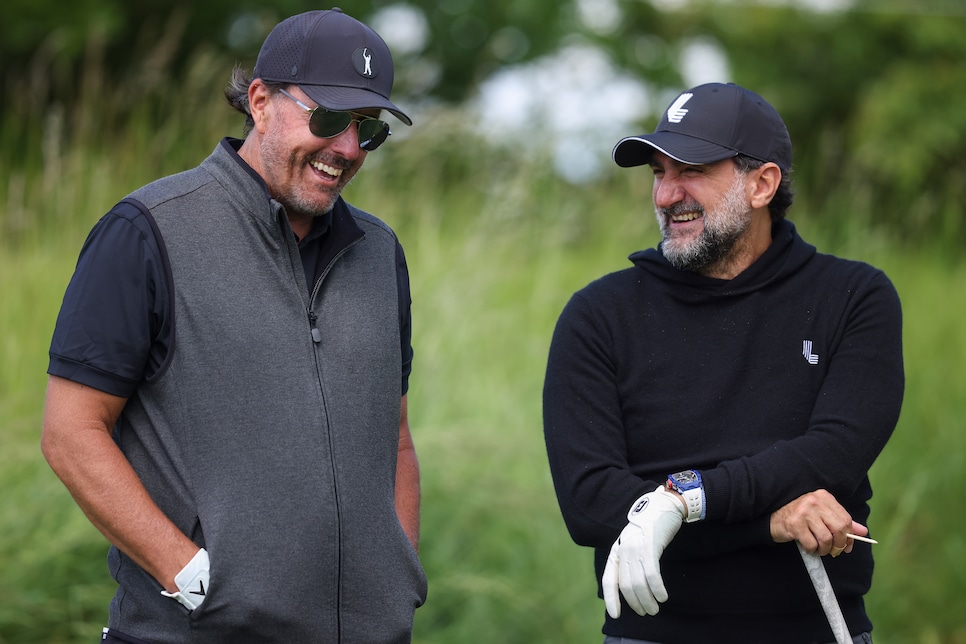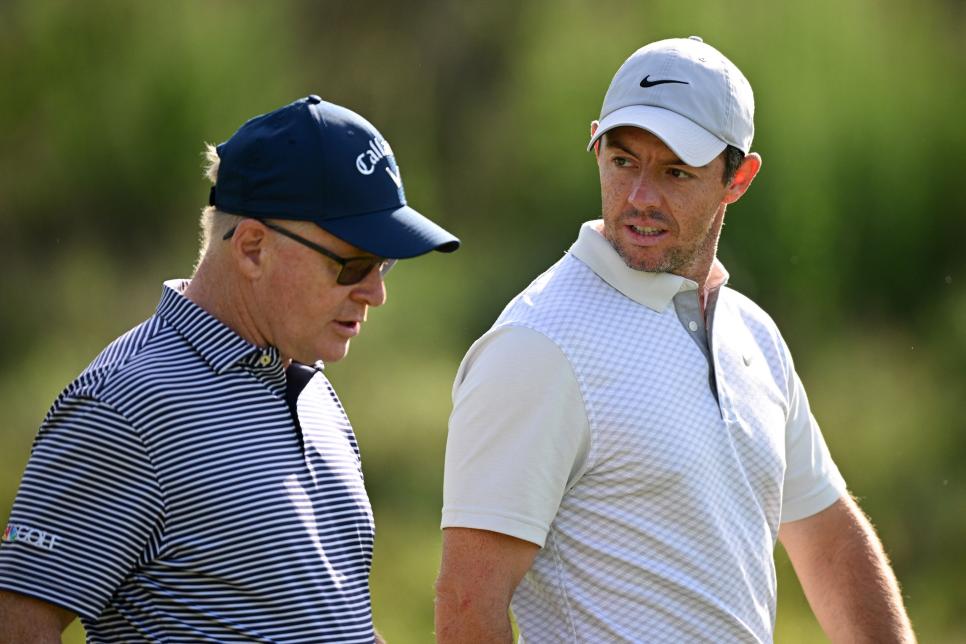[PHOTO: Jared C. Tilton]
The PGA Tour is hosting its flagship event this week, but most of the talk in golf remains on its future rather than the present. It’s been nine months since the tour’s surprise proposed deal with Saudi Arabia’s Public Investment Fund, the financial backer of LIV Golf, and most of the sport remains in the dark about what the deal could mean. Though the incontrovertible takeaway from the past two years in professional golf is that no one knows anything, at least for certain, we’ve spent much of this week at TPC Sawgrass gathering intel on the status of the deal. Here are eight questions (and attempted answers) on the PGA Tour–PIF partnership ahead of the Players Championship.
Wasn’t the deal supposed to be done by now?
Not necessarily. The framework agreement struck by the PGA Tour and PIF announced on June 6 called for a more formal deal to be completed by December 31, although all sides had the right to push that date back. Sources familiar with the discussions told Golf Digest in December that the hope was to finish negotiations by this Players Championship. However, Players week is here and no deal has been finalised.
How close is a deal?
PGA Tour commissioner Jay Monahan was vague on details, although he mentioned multiple times during his annual State of the Tour address that talks with PIF are “accelerating”. Monahan later said members of the tour’s new investment partners (Strategic Sports Group) travelled to Saudi Arabia in January to meet with PIF governor Yasir Al-Rumayyan and PIF officials. Multiple sources have told Golf Digest discussions also happened in February, when Al-Rumayyan was in Miami for PIF’s FII Institute Conference. For those looking for a possible target date, a finished deal remains months, if not a year, away.
What is the hold-up?
Depends who you ask. Most of the tour’s focus in the second half of 2023 was on securing private-equity backing. The tour sought supplemental investment for multiple reasons. There was the belief it would appease government antitrust regulations, while other stakeholders simply didn’t want to deal with PIF. The latter sentiment could be partially attributed to hesitation in partnering with PIF given its role in golf’s civil war (to say nothing of the attached human-rights concerns), although there’s also a contingent of voices that were upset about the secretive nature of the framework agreement, and saw alternative investment to PIF as a personal rebuke of sorts to June 6.
However, when it comes to the PIF deal specifically, much of the delay can be chalked up to the notion that the tour itself is divided on what it wants. It’s no secret that the board of directors, tour leaders and tour membership is far from a united front, especially regarding many of the tour’s infrastructure changes over the past 18 months. Expect these debates to continue, with special focus on the signature event series, multiple sources tell Golf Digest. Essentially, the tour has to get its own house in order before it can have earnest discussions with PIF.
As for PIF, there is a sense that LIV Golf has been rejuvenated. The fledgling league was on life support: it failed to gain full traction with the golf populace over its first two seasons, no additional starpower defected after the inaugural campaign and LIV’s rejected application for world-ranking points meant LIV would not shed accusations that it’s nothing more than an exhibition. But Jon Rahm’s signing and the comeback of Anthony Kim have added intrigue for its third season. Whether that leads to any extra attention, or economic value, remains to be seen.

From the little they have talked, what obstacles remain between the tour and PIF?
The idea of power remains contentious. The tour, essentially, wants to give PIF a seat at the table with limited control, with the idea that this takes care of Saudi Arabia’s ultimate goal – to be legitimised by an American institution that can facilitate connections to other professional sports leagues in the USA. Conversely, PIF officials have countered that if they are investing billions into PGA Tour Enterprises, they expect to have a say in the organisation.
Regarding unification, PIF has argued for both LIV integration into the PGA Tour schedule, and for tour players to compete in LIV events. Monahan, who described his secret deal with PIF as a chance “to take the competitor off the board”, wants several LIV players under the tour umbrella, albeit with LIV shut down. Most of the top PGA Tour players – including Scottie Scheffler, Jordan Spieth, Justin Thomas and Tiger Woods – do not want LIV players back without some sort of penalty or retribution.
Another significant hurdle is the United States Congress, which is continuing its investigation into PIF and its investments in American businesses. Although many look at this as nothing more than political spectacle, as long as the investigation remains ongoing it presents challenges to a PGA Tour-PIF partnership, multiple sources tell Golf Digest.
How does SSG factor into this?
The tour announced that the deal with SSG will allow for co-investment from PIF in the future, and SSG, sources tell Golf Digest, made the deal with the tour under the belief that PIF involvement will ultimately come to fruition. However, most of the SSG’s focus has been on internal tour evaluation and how to improve the existing tour product. Though Monahan again remained vague on what this means, Rory McIlroy offered his opinions on what changes may be coming.
“I think the on-site experience is something that they’re going to heavily invest in,” McIlroy said at TPC Sawgrass. “So trying to get more, I don’t think every week has to be like a Phoenix Open, but I think having it be more of an event. You think of like Formula 1, for example, and it’s like, you go there and it’s a weekend of racing, but there’s so much else going on, and you get 400,000 people in through the gates on any given weekend. So creating more events like that where it’s a way to enhance the on-site experience for a fan.”
The broadcast presentation is another area of focus, sources tell Golf Digest, and on this front the tour is poised to make a strong move thanks to developments with PGA Tour Studios.
SSG is also thinking bigger than the tour. An often-cited example is the group attempting to purchase the PGA of America, thus bringing in the PGA Championship and Ryder Cup under the PGA Tour Enterprises umbrella. Sources with the PGA of America tell Golf Digest its organisation has no interest in an immediate sale, wanting to see how the PGA of America operation could flourish with its new Frisco property, but these are the type of endeavours SSG is imagining. Also expect golf properties to be added to the portfolio, both to host professional events and to create tourist experiences for amateur golfers.
Will Monahan survive all this change?
Players like Patrick Cantlay, Xander Schauffele and Viktor Hovland did not offer their public approval of Monahan this week, and privately… well, you can imagine what’s being said privately. Clearly navigating the past two years would have been difficult for anybody, but that doesn’t change the fact that Monahan has not handled this time with aplomb.
In that same breath, Monahan’s position has actually improved, as he was named the head of the new PGA Tour Enterprises and was given voting rights with the policy board. “Clearly given the responsibility I’ve been given by both boards, I have the support of our board, and I am the right person to lead us forward,” Monahan said. “I know that. I believe that in my heart, and I’m determined to do exactly that.” Monahan has his critics, but he’ll probably remain in charge of the tour until a deal with PIF is complete.

Wait, what is going with the DP World Tour?
This has quietly become the elephant in the room. When PGA Tour Enterprises was initially announced, the DP World Tour was supposed to have a seat on the board. But in last week’s release on board seats, the European circuit was left out in the cold. Similar to the PGA Tour’s issues, there is a divide between DP World Tour membership and leadership, with many players expressing disappointment in how their league has been relegated in the strategic alliance with the tour. PIF officials are aware of the discord, and should its deal with the PGA Tour grow cold, there’s a chance PIF – which initially made overtures to the DP World Tour years ago – could renew its pursuit. With DP World Tour chief executive Keith Pelley leaving soon, expect the Old World circuit’s future to become a big discussion point.
Could the PGA Tour–PIF deal fall apart?
Very much so. Though the no-poaching clause in the framework agreement was sidelined due to antitrust regulations, there was an unspoken understanding that recruiting was off-limits. The signing of Rahm, to many tour officials, ended this period of detente. PIF looked at Rahm as a bargaining chip amid worries the tour will ultimately walk away from the proposed framework agreement with its interest in private equity. There are those with the tour that think the SSG investment provides the financial stability PIF offered, while some influential tour members want LIV to remain simply for leverage purposes.
But, publicly, Monahan continues to express that a deal with PIF is the best outcome for everyone involved.
“Obviously it has to be the right deal for both sides, like any situation or negotiation,” Monahan said this week. “The conversations with SSG, for the reasons I just said, I think have enhanced the likelihood of us reaching a successful conclusion. When you bring in a group of investors in that consortium that combined have over 200 years of managing professional sports franchises in the US and internationally, and you bring in that level of expertise, I think that that is attractive to the PIF, and I think that we all – when you step back from it and you just look at where we are, and for some of the reasons I stated earlier, with the game booming, becoming cooler, becoming more mainstream, it’s truly global. There are a finite number of athletes, and this is a point in time, a unique point in time where unification ultimately puts the sport in the best possible position to take advantage of this growth on a go-forward basis.”
In short, peace is on the horizon. It’s just going to take a while to get there, and get everyone there together.



